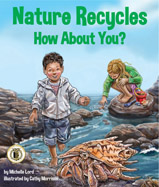Alignment to Standards for AZ

| Grade | Number | Standard |
|---|---|---|
| 1 | PO 2 | Compare the habitats (e.g., desert, forest, prairie, water, underground) in which plants and animals live. |
| 1 | PO 2 | Compare the following observable features of living things: movement _ legs, wings, protection _ skin, feathers, tree bark, respiration _ lungs, gills, support _ plant stems, tree trunks, |
| 1 | PO 2 | Identify characteristics of maps and globes: compass rose, symbols, map key/legend |
| 1 | PO 3 | Identify observable similarities and differences (e.g., number of legs, body coverings, size) between/among different groups of animals. |
| 1 | PO 5 | Identify ways to conserve natural resources (e.g., reduce, reuse, recycle, find alternatives). |
| 1,2 | PO 1 | Recognize different types of maps (e.g., political, physical) serve various purposes. |
| 1,2 | PO 4b | Recognize characteristics of human and physical features: human (i.e., equator, North and South Poles) |
| 1,2,3 | PO 5a | Locate physical and human features using maps, illustrations, images or globes: physical ((i.e., continent, ocean, river, lake, mountains, islands) |
| 1,2,3 | PO 5b | Locate physical and human features using maps, illustrations, images or globes: human (i.e., equator, North and South poles, country) |
| 1,2,3 | PO 6a | Recognize characteristics of human and physical features: physical (i.e., continent, ocean, river, lake, mountain range, coast, sea, desert, gulf, bay, strait, plain, valley, volcano, peninsula) |
| 2 | PO 1 | Identify animal structures that serve different functions (e.g., sensory, defense, locomotion). |
| 2 | PO 2 | Recognize ways of protecting natural resources. |
| 3 | PO 1 | Identify adaptations of plants and animals that allow them to live in specific environments. |
| 3 | PO 1 | Locate major physical and human features from content studied (e.g., Greece, Canada, Spain, United States) on maps and globes. |
| 3 | PO 2 | Describe ways of protecting natural resources. |
| 3 | PO 6b | human (i.e., Equator, Northern and Southern Hemispheres, North and South Poles, city) |
| 4 | PO 1 | Compare structures in plants (e.g., roots, stems, leaves, flowers) and animals (e.g., muscles, bones, nerves) that serve different functions in growth and survival. |
| 4 | PO 2 | Give examples of adaptations that allow plants and animals to survive. camouflage _ horned lizards, coyotes, mimicry _ Monarch and Viceroy butterflies, physical _ cactus spines, mutualism _ species of acacia that harbor ants, which repel other harmful ins |
| 4 | PO 4 | Describe ways in which resources can be conserved (e.g., by reducing, reusing, recycling, finding substitutes). |
| K | PO 1 | Recognize the differences between maps and globes. |
| K | PO 4 | Identify ways some natural or man-made materials can be reused or recycled (e.g., efficient use of paper, recycle aluminum cans). |